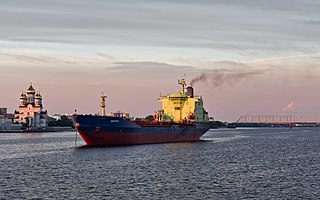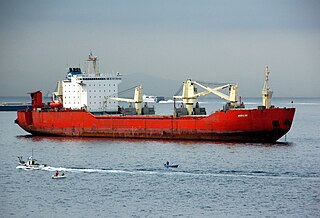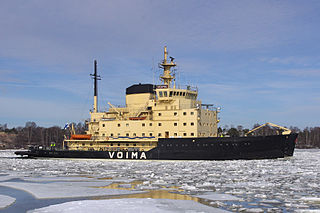
An icebreaker is a special-purpose ship or boat designed to move and navigate through ice-covered waters, and provide safe waterways for other boats and ships. Although the term usually refers to ice-breaking ships, it may also refer to smaller vessels, such as the icebreaking boats that were once used on the canals of the United Kingdom.

MV Captain Kurbatskiy was a Russian SA-15 type cargo ship originally known as Nizhneyansk (Нижнеянск) after a port of the same name. The ship was delivered from Valmet Vuosaari shipyard in 1983 as the second ship of a series of 19 icebreaking multipurpose arctic freighters built by Valmet and Wärtsilä, another Finnish shipbuilder, for the Soviet Union for year-round service in the Northern Sea Route. These ships, designed to be capable of independent operation in arctic ice conditions, were of extremely robust design and had strengthened hulls resembling those of polar icebreakers.

MSV Fennica is a Finnish multipurpose icebreaker and offshore support vessel. Built in 1993 by Finnyards in Rauma, Finland and operated by Arctia Offshore, she was the first Finnish icebreaker designed to be used as an escort icebreaker in the Baltic Sea during the winter months and in offshore construction projects during the open water season. Fennica has an identical sister ship, Nordica, built in 1994.

MT Alma is an Aframax crude oil tanker. Formerly known as Mastera for almost two decades and briefly as Mikines in early 2022, she and her sister ship Tempera were the first ships to utilize the double acting tanker (DAT) concept in which the vessel is designed to travel ahead in open water and astern in severe ice conditions. The icebreaking tanker was built to transport crude oil year-round from the Russian oil terminal in Primorsk to Neste Oil refineries in Porvoo and Naantali.

La Noumbi is a floating production storage and offloading (FPSO) unit operated by Perenco. The vessel, converted from the former Finnish Aframax crude oil tanker Tempera by Keppel Corporation, will replace an older FPSO unit in the Yombo field off the Republic of Congo in 2018.

Ice class refers to a notation assigned by a classification society or a national authority to denote the additional level of strengthening as well as other arrangements that enable a ship to navigate through sea ice. Some ice classes also have requirements for the ice-going performance of the vessel.

Polar Class (PC) refers to the ice class assigned to a ship by a classification society based on the Unified Requirements for Polar Class Ships developed by the International Association of Classification Societies (IACS). Seven Polar Classes are defined in the rules, ranging from PC 1 for year-round operation in all polar waters to PC 7 for summer and autumn operation in thin first-year ice.

Fednav is a privately owned Canadian company in the maritime transport industry, involved in transporting over 30 million tonnes of bulk cargo and break bulk cargo worldwide. Its fleet comprises approximately 120 owned, long-term chartered, and spot chartered vessels and includes most of St. Lawrence Seaway's maximum-sized bulk carriers, Supramax, and Panamax vessels.

MT Varzuga was an ice-strengthened product tanker that sailed under the Finnish flag in 1977–2003 and under the Russian flag in 2003–2021. After her modernization in 1993, she became the first merchant ship to be equipped with Azipod, an electric azimuthing propulsion unit developed in Finland in the late 1980s. She was also the first non-Soviet ship to transit the Northern Sea Route.

SA-15 is the project name for a series of icebreaking multipurpose cargo ships built in Finland for the Soviet Union in the 1980s. The ships, capable of independent operation in all prevailing arctic ice conditions, were the first merchant vessels designed for year-round operations in the Northern Sea Route. For this purpose they have hulls that resemble those of polar icebreakers and propulsion systems capable of withstanding ice loads.

Louhi is a Finnish multipurpose oil and chemical spill response vessel owned by the Finnish Environment Institute (SYKE), but manned and operated by the Finnish Navy. The ship, ordered in 2007, was built by Uki Workboat in Uusikaupunki, Finland, and entered service in May 2011.

MSV Botnica is a multipurpose offshore support vessel and icebreaker built by Finnyards in Rauma, Finland, in 1998. She was the newest and technically most advanced state-owned icebreaker of Finland until 2012, when she was sold to the Port of Tallinn for 50 million euro. Botnica is used as an escort icebreaker in the Baltic Sea during the winter months, but carries out subsea and offshore construction works worldwide during the open water season.
Arcticaborg (Арктикаборг) is an icebreaking platform supply vessel. She was previously operated by Wagenborg Kazakhstan in the Caspian Sea but was transferred to Canada in 2017 and acquired by Fathom Offshore in 2018. In 2019, she was contract to Russia for two years.

MSV Nordica is a Finnish multipurpose icebreaker and offshore support vessel. Built in 1994 by Finnyards in Rauma, Finland, and operated by Arctia Offshore, she and her sister ship Fennica were the first Finnish icebreakers designed to be used as escort icebreakers in the Baltic Sea during the winter months and in offshore construction projects during the open water season.

Voima is a Finnish state-owned icebreaker. Built by Wärtsilä Hietalahti shipyard in Helsinki in 1954, she was the first icebreaker in the world to be equipped with two bow propellers and generated widespread publicity that helped the Finnish shipbuilding industry to become the world leader in icebreaker design.

Otso is a Finnish state-owned icebreaker. Built by Wärtsilä Helsinki shipyard in 1986 to replace the aging Karhu-class icebreakers, she was the first Finnish post-war icebreaker to be built without bow propellers. Otso has an identical sister ship, Kontio, which was delivered in 1987.

Katarina is a Finnish training ship of the Kotka School of Nautical Studies. Built by Valmet in Helsinki in 1953 as Aranda, she was the second vessel to bear the name. Until 1989, she served as a transport vessel for the Finnish National Board of Navigation and a research vessel for the Finnish Institute of Marine Research.

Kaj Antero Riska is a naval architect and engineer with expertise in ice and arctic technology. He has written various publications about ice-going ships and icebreaker design, ice loads and ice management for arctic offshore floating platforms. He worked at Total S.A. as Senior Ice Engineer. He received the 2019 POAC Founders Lifetime Achievement Award.

Polaris is a Finnish icebreaker. Built in 2016 by Arctech Helsinki Shipyard, she is the most powerful icebreaker ever to fly the Finnish flag and the first icebreaker in the world to feature environmentally friendly dual-fuel engines capable of using both low-sulfur marine diesel oil (LSMDO) and liquefied natural gas (LNG). Polaris was initially ordered by the Finnish Transport Agency, but the ownership was transferred to the state-owned icebreaker operator Arctia after delivery.

Ice navigation vessel or Ice-strengthened vessel is a class of ships specially prepared for independent ice navigation in the waters of the polar seas and for following icebreakers in especially difficult ice conditions. Various registration authorities assign ice classes to vessels based on their technical characteristics. Due to this, ice navigation vessels are usually referred to as ice-class vessels without indicating which class they belong to, but indicating the type of vessel.






















